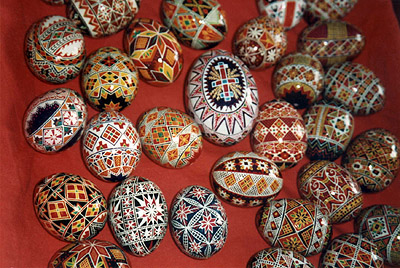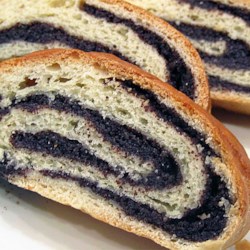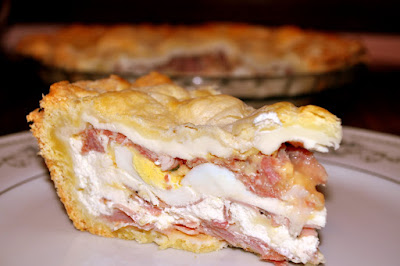My friend Ama married into a Polish family here in the US. She and I email back and forth since we live on opposite sides of the country. In her last email she mentioned how she was supposed to get her 7 month old's basket together to be blessed, but she didn't really understand why. This was my chance to enlightened her, from personal experience. My Mom and I used to get baskets together to be blessed for Easter.
Like most Catholic traditions, Easter is steeped in pagan tradition, which was assimilated with the conquered people and watered down by Americans in the melting pot days. Different websites offer different reasons or explanations for why items are included in the basket, both Polish and Ukrainian. Some even go into all the Slavic countries/areas traditions. I wish I had the books my Mom has, which explains everything including why it is part of the tradition. I found only one website that mentions the basket linen as being judged by the community on the skill (or worth) of the woman or girl who made it. One book I had mentioned that girls would put the basket out to be inspected by the boys in hopes of a future husband picking her, a way to show off her homemaker skills in baking, sewing, and embroidery. And so we have beautiful baskets filled with hard work and delicious foods which were given up during Lent. Check out these websites for info and pictures:
http://www.brama.com/art/easter.html
http://www.polishcenter.org/polish_easter_traditions.htm
http://www.ukrainian-n-things.com/basketphotos.htm
Brama goes into great detail about the Ukrainian history of Easter and has some great pictures. "The traditions which originated in the ancient, pre-Christian times in Ukraine reflected the religious outlook, social structure and the way of life of the people...With the introduction of Christianity to Ukraine in 988 A.D. the Church adopted many of these annual rituals into the Christian holidays. As a result the Ukrainian traditions are rich and deeply symbolic in their content."
 |
| http://www.pasgc.org/ |
Polish Easter Traditions include (reasons vary widely):
* Egg (pisanka)—Symbol of life and rebirth.
*
Sausage (kielbasa) or ham—All
types of pork were forbidden under the dietary code of the Old Testament
(Leviticus 11.7). The coming of Christ was seen as exceeding the old law
and the dietary items now became acceptable (Mark 7.19).
*
Paschal lamb—It can
be made of butter, cake or even plaster. It is the centerpiece of the
meal. Christ is seen as the "Lamb of God."
*
Horseradish/pepper—Symbolize
the bitter herbs of the Passover and the Exodus.
*
Salt—Joins
bread in Polish tradition as a sign of hospitality.
*
Bread—Christ
has been called "the Bread of Life."
*
Vinegar—Symbolizes
the gall given to Christ at the crucifixion.
*
Wine—Symbolizes
the blood of sacrifice spilled by Christ at the crucifixion.
Or from the amazing website The Polish American Journal (has a ton of info!):
"A
basket is decorated with green parsley, flowers, and sprigs of pussy
willow or boxwood (bukszpan), with a ribbon woven
through the handle, and covered with a lace or
embroidered doily. The basket traditionally contains: a Paschal lamb —
baranek wielkanocny made of butter, cake or sugar and carrying in a
cross-balanced position, a small banner
sometimes with the letters IHS (representing the lamb of
God); hand painted and decorated eggs — pisanki (the symbol of new
life); meat (signifying prosperity); horseradish (a bitter herb,
signifying the suffering of Christ);
salt (a Polish tradition of welcome and hospitality);
greenery (the awakening of the earth); and bread/babka (a symbol of
communion and the Last Supper). This would ensure a good harvest and
sufficient amount of food for coming
year. "
 |
| http://www.brama.com |
~I have used wax to make decorations on the eggs. Someday I will move up to the fancy decorated eggs, but it is a seriously long, hard process. The outcome is so worth it but until I have the time to devote to it, it is on my bucket list.
One thing that is not listed but is in some of the pictures is Makowiec, poppy seed bread/roll. A delicious sweet bread rolled out and filled with sweet poppy seed filling, then rolled and baked. Some people put icing on it, we never did. Ugh, this is my absolute favorite.
 |
| Linda http://allrecipes.com |
I was talking with some neighbors and apparently the thing to do now is fill fake plastic eggs with candy or chocolate and hide those. Some friends were telling me that thier kids don't get candy, they get clothes, and toys, and books....just like Christmas? I realized growing up, we were religious, Catholic specifically, and so traditions stayed with each holiday and did not mix. They each had their special things we looked forward to, including or especially the food. Like the eggs, for example, we dyed real chicken eggs which were hard boiled. Those were hidden for us to find, not fake eggs. And then we ate them for breakfast. We did have a basket of candy, maybe some pencils or erasers, or small toys but that was it.
 |
| www.blessedsacramentmke.org |
This year we had ham, my diet gravy mix, mazto ball soup, and mashed potatoes. Matzo ball soup is more a Jewish thing, but we have it all the time and especially on holidays. I just can't not have a multicultural holiday. Really, this year it was all leftovers, or easy box stuff and with both of us working or busy until the day of, neither of us thought of buying anything as I am leaving for a week long conference. The ham was frozen, leftover from Christmas, the gravy mix was in a packet, the soup a box. The potatoes were real potatoes, boiled with a chopped onion. Delic!
For a few years of my childhood we made Italian Easter Pie. It weighed a million pounds and one piece could probably last you all day working out in the fields. It was delicious, but a whole meal in that single slice. I found a great recipe similar to ours at a fellow blogger’s site:
ouritaliankitchen.blogspot.com/2010/04/pizzagaina-italian-easter-pie.html.
 |
| Pizzagaina (Italian Easter Pie) |
I hope you learned something this Easter and were able to share a relaxing, joyous day! Feel free to share your menu or traditions.
No comments:
Post a Comment